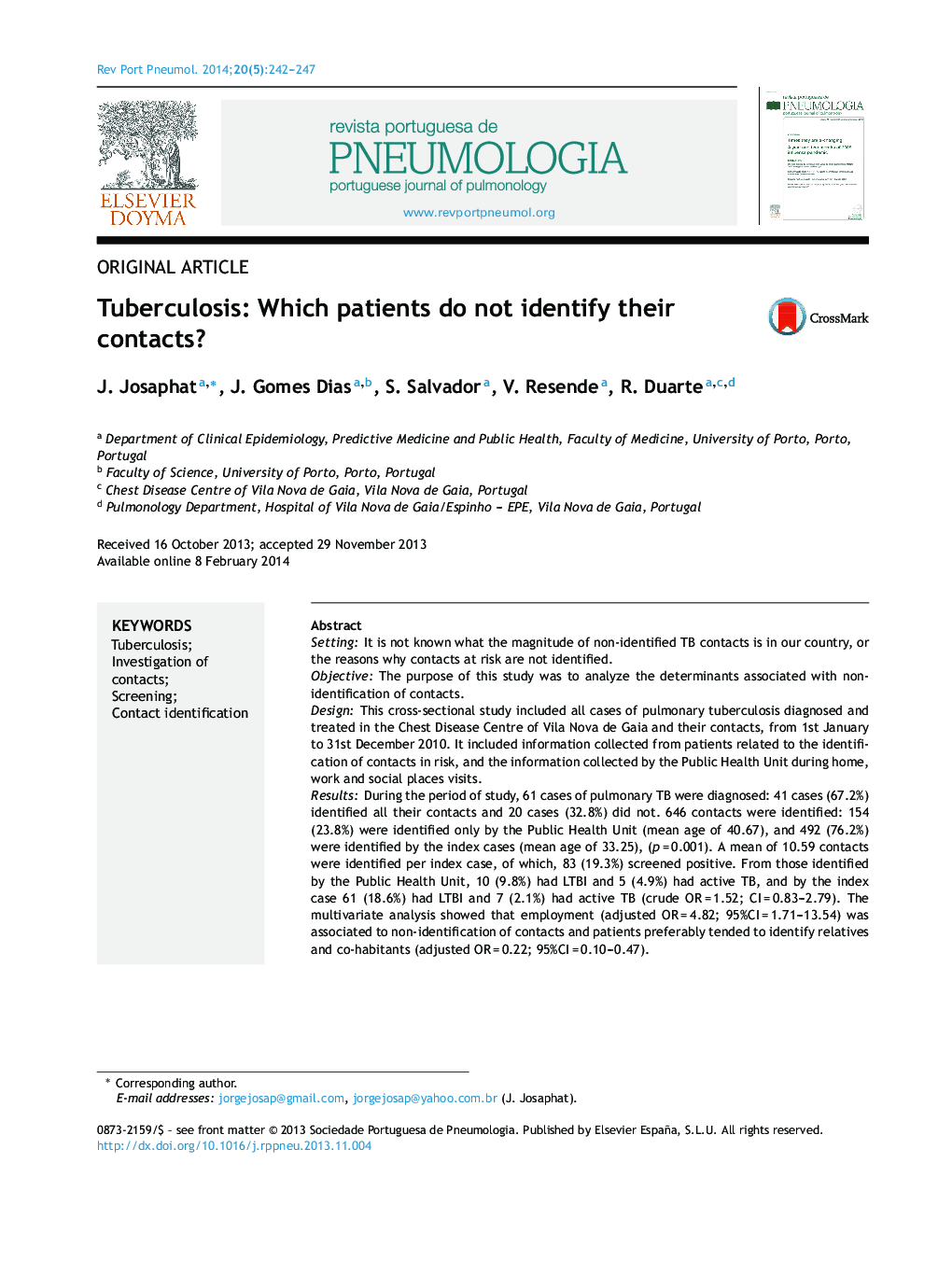| کد مقاله | کد نشریه | سال انتشار | مقاله انگلیسی | نسخه تمام متن |
|---|---|---|---|---|
| 4213722 | 1280934 | 2014 | 6 صفحه PDF | دانلود رایگان |
SettingIt is not known what the magnitude of non‐identified TB contacts is in our country, or the reasons why contacts at risk are not identified.ObjectiveThe purpose of this study was to analyze the determinants associated with non‐identification of contacts.DesignThis cross‐sectional study included all cases of pulmonary tuberculosis diagnosed and treated in the Chest Disease Centre of Vila Nova de Gaia and their contacts, from 1st January to 31st December 2010. It included information collected from patients related to the identification of contacts in risk, and the information collected by the Public Health Unit during home, work and social places visits.ResultsDuring the period of study, 61 cases of pulmonary TB were diagnosed: 41 cases (67.2%) identified all their contacts and 20 cases (32.8%) did not. 646 contacts were identified: 154 (23.8%) were identified only by the Public Health Unit (mean age of 40.67), and 492 (76.2%) were identified by the index cases (mean age of 33.25), (p = 0.001). A mean of 10.59 contacts were identified per index case, of which, 83 (19.3%) screened positive. From those identified by the Public Health Unit, 10 (9.8%) had LTBI and 5 (4.9%) had active TB, and by the index case 61 (18.6%) had LTBI and 7 (2.1%) had active TB (crude OR = 1.52; CI = 0.83–2.79). The multivariate analysis showed that employment (adjusted OR = 4.82; 95%CI = 1.71–13.54) was associated to non‐identification of contacts and patients preferably tended to identify relatives and co‐habitants (adjusted OR = 0.22; 95%CI = 0.10–0.47).ConclusionTB patients tend to identify relatives and co‐habitant contacts; contact at place of employment was found to be an independent risk factor for not being identified.
ResumoContextoNão é conhecida a magnitude dos contactos de TB não identificados no nosso país, nem os motivos porque os contactos em risco não são identificados.ObjetivoO objetivo deste estudo foi analisar as determinantes associadas à não‐identificação dos contactos.Materiais e MétodosEste estudo transversal incluiu todos os casos de tuberculose pulmonar diagnosticados e tratados no Centro de Doenças Pulmonares de Vila Nova de Gaia e os seus contactos, de 1 de janeiro a 31 de dezembro de 2010. Incluiu a informação recolhida de doentes relacionada com a identificação dos contactos em risco e a informação recolhida pela Unidade de Saúde Pública durante as visitas ao domicílio, ao trabalho e a espaços sociais.ResultadosDurante o período de estudo, foram diagnosticados 61 casos de TB pulmonar: 41 casos (67,2%) identificaram todos os seus contactos e 20 casos (32,8%) não o fizeram. Foram identificados 646 contactos: 154 (23,8%) foram identificados apenas pela Unidade de Saúde Pública (idade média de 40,67 anos) e 492 (76,2%) foram identificados pelos casos índice (idade média de 33,25, p = 0,001). Foram identificados uma média de 10,59 contactos por Caso Índice, dos quais 83 (19,3%) rastreados como positivos. Dos identificados pela Unidade de Saúde Pública, 10 (9,8%) tinham uma LTBI (infeção tuberculosa latente) e 5 (4,9%) TB ativa, e pelo Caso Índice, 61 (18,6%) tinham LTBI e 7 (2,1%) TB ativa, (OR bruto = 1,52; CI = 0,83–2,79). A análise multivariada mostrou que o emprego (OR ajustado = 4,82; 95% CI = 1,71–13,54) estava associado à não identificação de contactos e os doentes tinham tendência, preferencialmente, a identificar familiares e coabitantes (OR ajustado = 0,22; 95% CI = 0,10–0,47).ConclusãoOs doentes com TB tendem a identificar os contactos de familiares e coabitantes; os contactos no local de trabalho foram considerados um fator de risco independente para não ser identificado.
Journal: Revista Portuguesa de Pneumologia - Volume 20, Issue 5, September–October 2014, Pages 242–247
